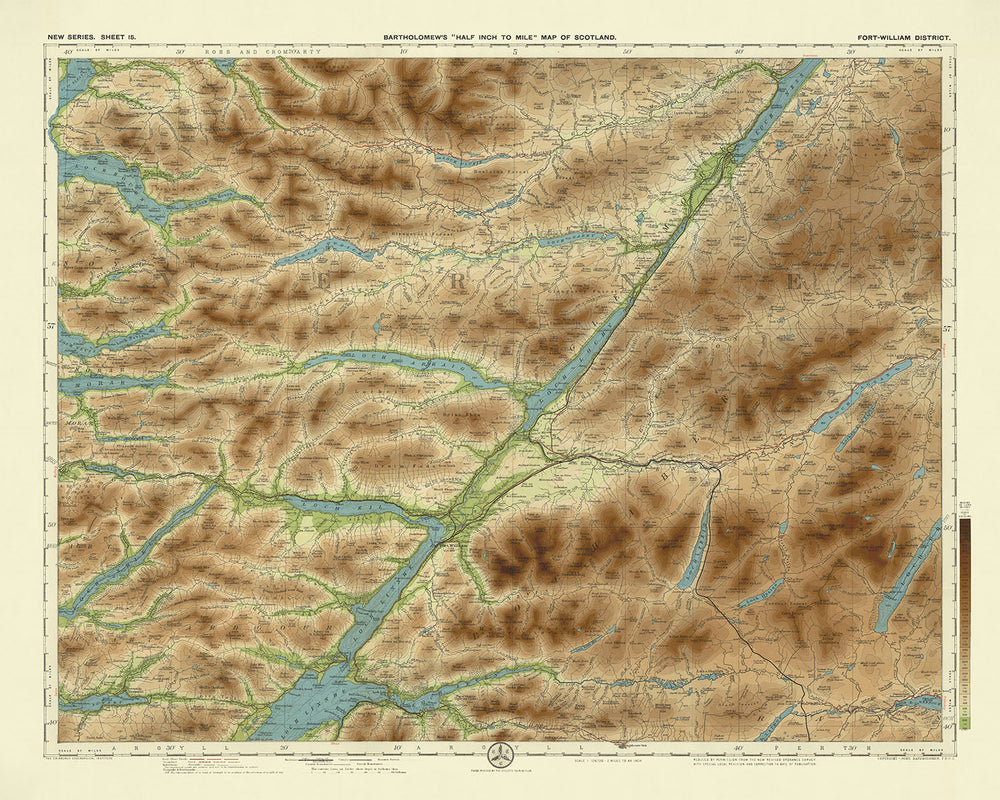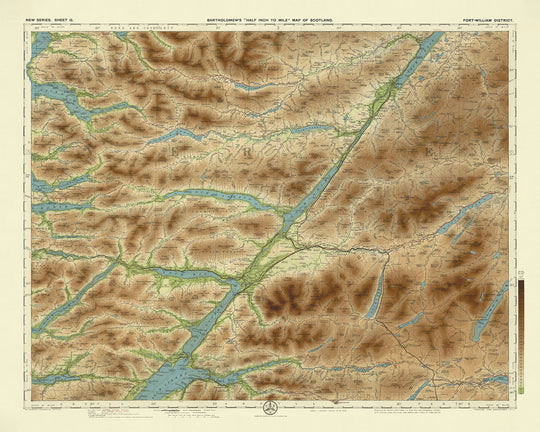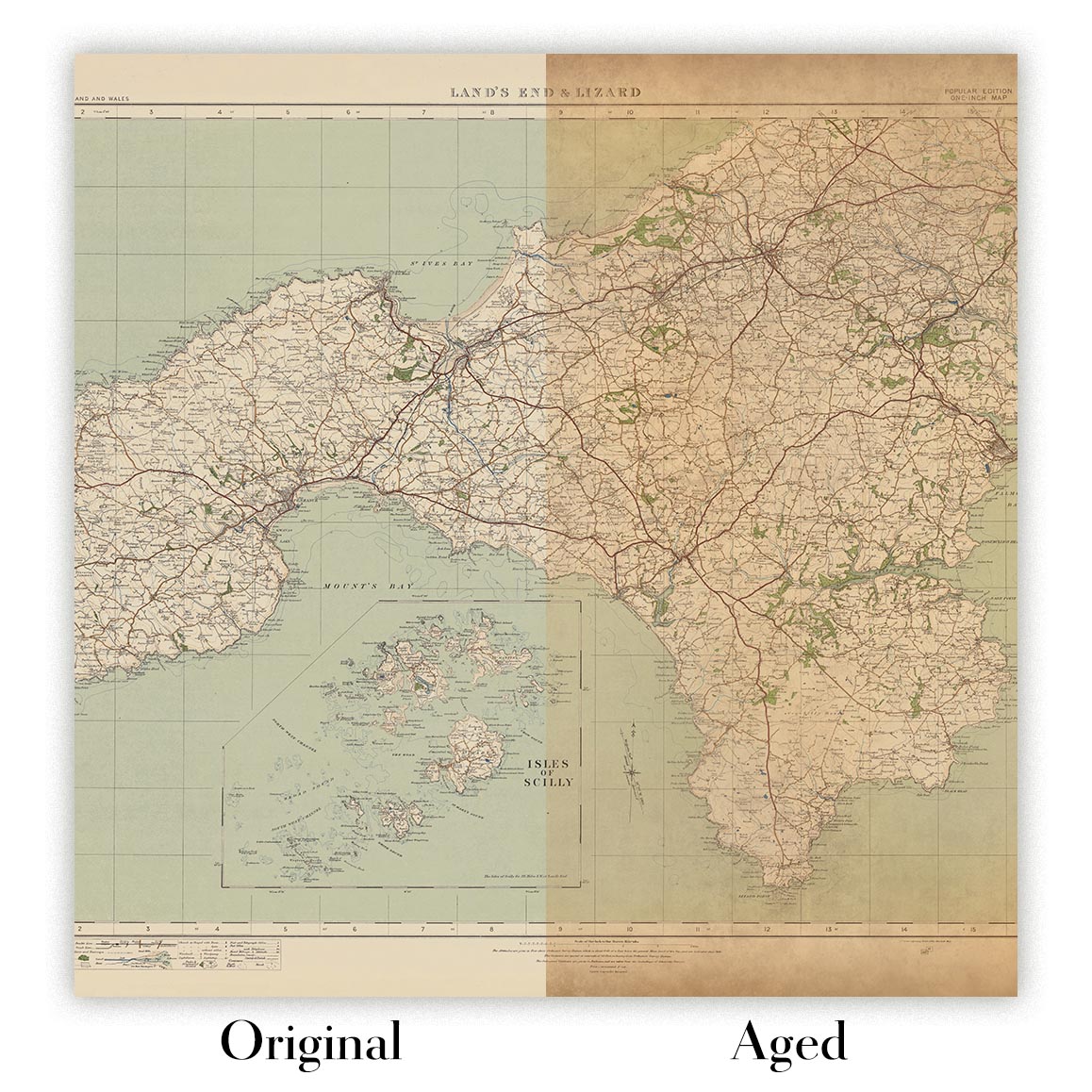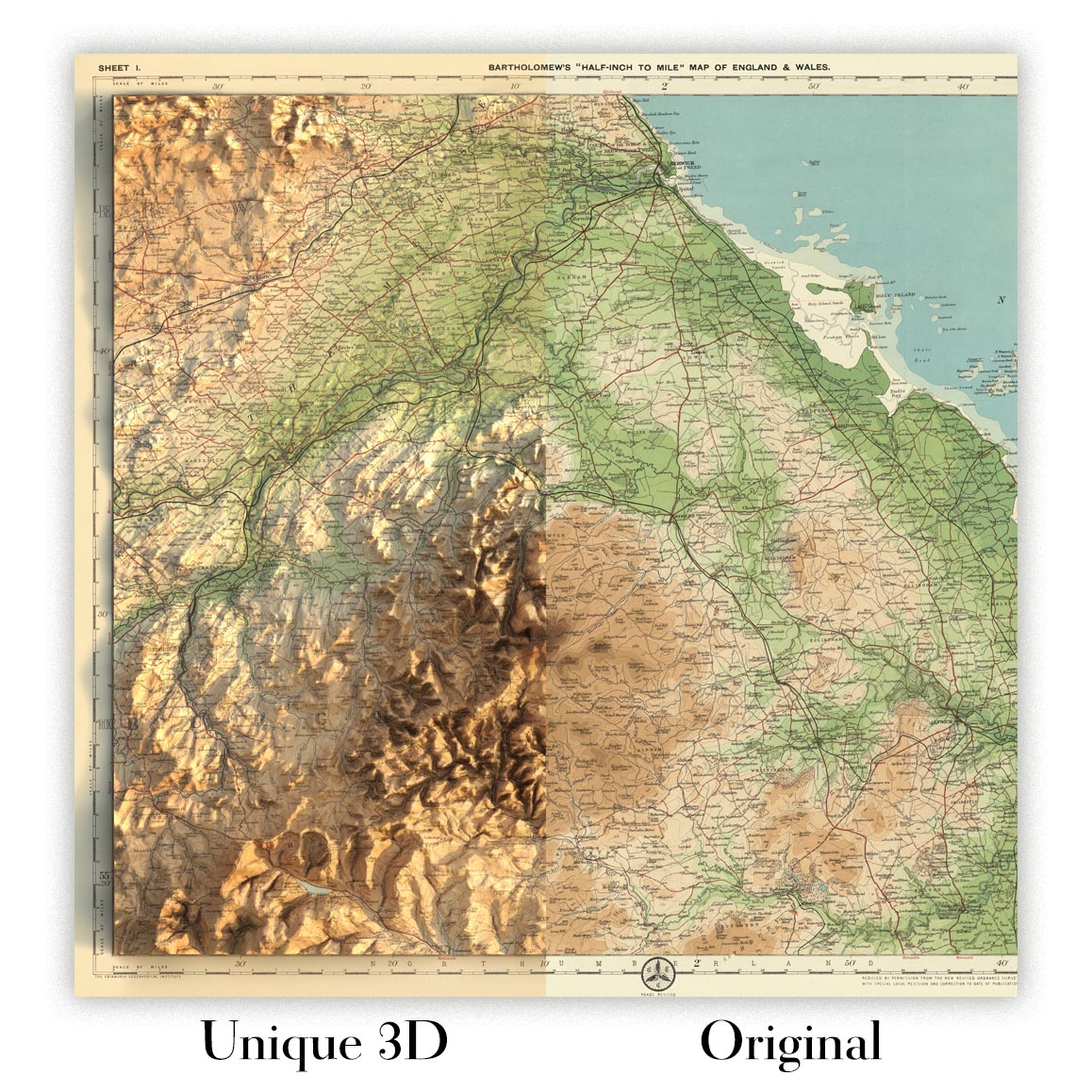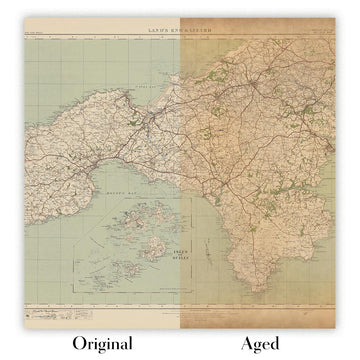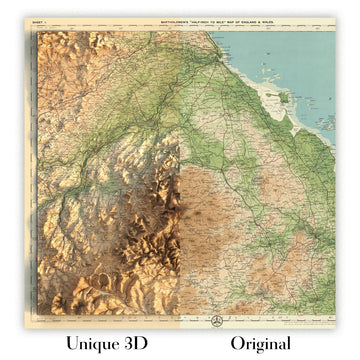- Handmade locally. No import duty or tax
- FREE Delivery by Christmas
- Love it or your money back (90 days)
- Questions? WhatsApp me any time
Own a piece of history
5,000+ 5 star reviews


Step back in time with the exquisite "Sheet 15 - Fort William District," a captivating map crafted by the renowned cartographer JG Bartholomew in 1901. This masterpiece, part of Bartholomew's celebrated Half-Inch series, offers a meticulous representation of the Fort-William District in the Scottish Highlands. Known for his detailed and aesthetically pleasing maps, Bartholomew's work stands as a testament to the art and science of early 20th-century cartography. His maps were particularly popular among cyclists and tourists, providing not only navigational aid but also a visual delight with their rich, layered colours and precise detailing.
The map's design is a marvel of cartographic innovation, utilizing subtle gradations of colour to depict the varied landscape relief. This technique allows the viewer to easily discern the heights and depths of the region's topography, from the towering peaks of Ben Nevis and Aonach Mòr to the serene valleys of Glen Nevis and the Great Glen. The careful use of colour bands creates a three-dimensional effect, bringing the rugged beauty of the Scottish Highlands to life. This map is based on a reduced Ordnance Survey map of the same period, ensuring both accuracy and historical authenticity.
The Fort-William District map is rich in geographical features, showcasing the intricate network of lochs, rivers, and glens that define this part of Scotland. Notable bodies of water such as Loch Ness, Loch Lochy, and Loch Linnhe are prominently displayed, along with the meandering courses of the River Lochy and River Spean. The Caledonian Canal, a marvel of engineering from the early 19th century, also makes an appearance, connecting the lochs and providing a vital waterway through the Highlands. These features not only highlight the natural beauty of the region but also its historical significance as a hub of transportation and trade.
In addition to its physical features, the map provides a glimpse into the political landscape of the time, with detailed boundaries and settlements marked with precision. The towns of Fort William, Spean Bridge, Invergarry, Drumnadrochit, and Fort Augustus are clearly labeled, offering a snapshot of the human geography of the early 1900s. Each settlement is a portal to the past, inviting exploration of their historical and cultural contexts. Fort William, for instance, is not only a gateway to Ben Nevis but also a town steeped in history, from its origins as a garrison town to its role in the Jacobite uprisings.
Owning this map is akin to possessing a piece of history, a beautifully crafted artifact that captures the essence of the Scottish Highlands over a century ago. It is a perfect addition for collectors, history enthusiasts, or anyone with a passion for the art of cartography. JG Bartholomew's "Sheet 15 - Fort-William District" is more than just a map; it is a journey through time, a detailed and vibrant portrayal of a region renowned for its natural splendor and historical depth.
Cities and towns on this map
- Inverness-shire:
- Fort William
- Spean Bridge
- Invergarry
- Drumnadrochit
- Fort Augustus
Notable Features & Landmarks
- Lochs:
- Loch Ness
- Loch Lochy
- Loch Linnhe
- Loch Eil
- Loch Arkaig
- Loch Oich
- Loch Quoich
- Loch Garry
- Rivers:
- River Lochy
- River Spean
- River Garry
- Mountains and Hills:
- Ben Nevis (highest peak in the UK)
- Aonach Mòr
- Carn Mor Dearg
- The Grey Corries
- Valleys and Glens:
- Glen Nevis
- Great Glen
- Glen Spean
- Canals:
- Caledonian Canal
Historical and design context
- Name of the map: Sheet 15 - Fort-William District
- Scale: Half-inch to the mile (1:126,720)
- Purpose: Popular with cyclists and tourists; Bartholomew's flagship series
- Design:
- Utilizes different layers of colour to represent landscape relief
- Subtle and innovative gradation of colour bands to show land at different heights
- Creation date: 1901
- Mapmaker/Publisher: JG Bartholomew
- Context about the mapmaker: JG Bartholomew was a renowned Scottish cartographer, known for his detailed and aesthetically pleasing maps. His work was influential in the field of cartography during the late 19th and early 20th centuries.
- Design style:
- Based on a reduced Ordnance Survey map from the same period
- Landscape map covering 36 miles from north to south and 52 miles from west to east
- Historical significance:
- Reflects the cartographic techniques and artistic styles of the early 20th century
- Provides insight into the geographical understanding and political boundaries of the time
Please double check the images to make sure that a specific town or place is shown on this map. You can also get in touch and ask us to check the map for you.
This map looks great at every size, but I always recommend going for a larger size if you have space. That way you can easily make out all of the details.
This map looks amazing at sizes all the way up to 70in (180cm). If you are looking for a larger map, please get in touch.
Please note: the labels on this map are hard to read if you order a map that is 20in (50cm) or smaller. The map is still very attractive, but if you would like to read the map easily, please buy a larger size.
The model in the listing images is holding the 18x24in (45x60cm) version of this map.
The fifth listing image shows an example of my map personalisation service.
If you’re looking for something slightly different, check out my collection of the best old maps to see if something else catches your eye.
Please contact me to check if a certain location, landmark or feature is shown on this map.
This would make a wonderful birthday, Christmas, Father's Day, work leaving, anniversary or housewarming gift for someone from the areas covered by this map.
This map is available as a giclée print on acid free archival matte paper, or you can buy it framed. The frame is a nice, simple black frame that suits most aesthetics. Please get in touch if you'd like a different frame colour or material. My frames are glazed with super-clear museum-grade acrylic (perspex/acrylite), which is significantly less reflective than glass, safer, and will always arrive in perfect condition.
This map is also available as a float framed canvas, sometimes known as a shadow gap framed canvas or canvas floater. The map is printed on artist's cotton canvas and then stretched over a handmade box frame. We then "float" the canvas inside a wooden frame, which is available in a range of colours (black, dark brown, oak, antique gold and white). This is a wonderful way to present a map without glazing in front. See some examples of float framed canvas maps and explore the differences between my different finishes.
For something truly unique, this map is also available in "Unique 3D", our trademarked process that dramatically transforms the map so that it has a wonderful sense of depth. We combine the original map with detailed topography and elevation data, so that mountains and the terrain really "pop". For more info and examples of 3D maps, check my Unique 3D page.
For most orders, delivery time is about 3 working days. Personalised and customised products take longer, as I have to do the personalisation and send it to you for approval, which usually takes 1 or 2 days.
Please note that very large framed orders usually take longer to make and deliver.
If you need your order to arrive by a certain date, please contact me before you order so that we can find the best way of making sure you get your order in time.
I print and frame maps and artwork in 23 countries around the world. This means your order will be made locally, which cuts down on delivery time and ensures that it won't be damaged during delivery. You'll never pay customs or import duty, and we'll put less CO2 into the air.
All of my maps and art prints are well packaged and sent in a rugged tube if unframed, or surrounded by foam if framed.
I try to send out all orders within 1 or 2 days of receiving your order, though some products (like face masks, mugs and tote bags) can take longer to make.
If you select Express Delivery at checkout your order we will prioritise your order and send it out by 1-day courier (Fedex, DHL, UPS, Parcelforce).
Next Day delivery is also available in some countries (US, UK, Singapore, UAE) but please try to order early in the day so that we can get it sent out on time.
My standard frame is a gallery style black ash hardwood frame. It is simple and quite modern looking. My standard frame is around 20mm (0.8in) wide.
I use super-clear acrylic (perspex/acrylite) for the frame glass. It's lighter and safer than glass - and it looks better, as the reflectivity is lower.
Six standard frame colours are available for free (black, dark brown, dark grey, oak, white and antique gold). Custom framing and mounting/matting is available if you're looking for something else.
Most maps, art and illustrations are also available as a framed canvas. We use matte (not shiny) cotton canvas, stretch it over a sustainably sourced box wood frame, and then 'float' the piece within a wood frame. The end result is quite beautiful, and there's no glazing to get in the way.
All frames are provided "ready to hang", with either a string or brackets on the back. Very large frames will have heavy duty hanging plates and/or a mounting baton. If you have any questions, please get in touch.
See some examples of my framed maps and framed canvas maps.
Alternatively, I can also supply old maps and artwork on canvas, foam board, cotton rag and other materials.
If you want to frame your map or artwork yourself, please read my size guide first.
My maps are extremely high quality reproductions of original maps.
I source original, rare maps from libraries, auction houses and private collections around the world, restore them at my London workshop, and then use specialist giclée inks and printers to create beautiful maps that look even better than the original.
My maps are printed on acid-free archival matte (not glossy) paper that feels very high quality and almost like card. In technical terms the paper weight/thickness is 10mil/200gsm. It's perfect for framing.
I print with Epson ultrachrome giclée UV fade resistant pigment inks - some of the best inks you can find.
I can also make maps on canvas, cotton rag and other exotic materials.
Learn more about The Unique Maps Co.
Map personalisation
If you're looking for the perfect anniversary or housewarming gift, I can personalise your map to make it truly unique. For example, I can add a short message, or highlight an important location, or add your family's coat of arms.
The options are almost infinite. Please see my map personalisation page for some wonderful examples of what's possible.
To order a personalised map, select "personalise your map" before adding it to your basket.
Get in touch if you're looking for more complex customisations and personalisations.
Map ageing
I have been asked hundreds of times over the years by customers if they could buy a map that looks even older.
Well, now you can, by selecting Aged before you add a map to your basket.
All the product photos you see on this page show the map in its Original form. This is what the map looks like today.
If you select Aged, I will age your map by hand, using a special and unique process developed through years of studying old maps, talking to researchers to understand the chemistry of aging paper, and of course... lots of practice!
If you're unsure, stick to the Original colour of the map. If you want something a bit darker and older looking, go for Aged.
If you are not happy with your order for any reason, contact me and I'll get it fixed ASAP, free of charge. Please see my returns and refund policy for more information.
I am very confident you will like your restored map or art print. I have been doing this since 1984. I'm a 5-star Etsy seller. I have sold tens of thousands of maps and art prints and have over 5,000 real 5-star reviews. My work has been featured in interior design magazines, on the BBC, and on the walls of dozens of 5-star hotels.
I use a unique process to restore maps and artwork that is massively time consuming and labour intensive. Hunting down the original maps and illustrations can take months. I use state of the art and eye-wateringly expensive technology to scan and restore them. As a result, I guarantee my maps and art prints are a cut above the rest. I stand by my products and will always make sure you're 100% happy with what you receive.
Almost all of my maps and art prints look amazing at large sizes (200cm, 6.5ft+) and I can frame and deliver them to you as well, via special oversized courier. Contact me to discuss your specific needs.
Or try searching for something!









